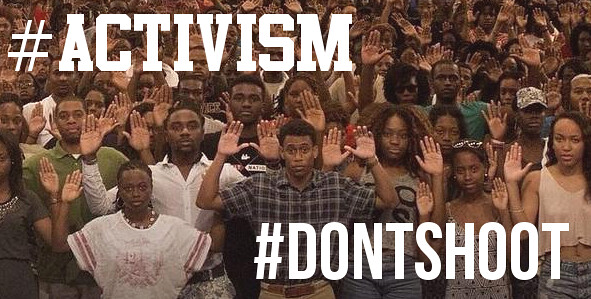I made the above graphic using GIMP and the well-known #DontShoot image taken at Harvard University (http://michigancitizen.com/mc/wp-content/uploads/2014/08/HU-students.jpg)
Planning the Project
Our group (Team 1) chose to do this module as we felt like “hashtag activism” was something that has currently been contributing to the spread of news. Users use hashtags to report or comment on information on various platforms such as Twitter, Tumblr, and Instagram. Looking at the list of recommended hashtags, I only recognized a few. This made me think about the lifetime of hashtags. Hashtags are very dependent on the environment and the time. Some hashtags keep going, but most die down. Some of the hashtags we discussed as a group in determining which our project would focus on were: #ALSIceBucketChallenge, and #DontShoot. I had also remembered the hashtags #BringBackOurGirls and #PrayforGaza. As a group, we decided to focus on #DontShoot, a product of the Michael Brown shooting which has sparked the creation of various other hashtags and is still bringing attention from the media.
Dividing the Work
The first week, Jessica set up the Twitter archive for #DontShoot. We divided the work depending on what aspects each of us wanted to focus on. Although the bulk of our presentation would be looking at the emergence of #DontShoot, other hashtags that have branched off of it, and what these hashtags aim to address. I wanted to research what citizen journalism is, and how citizen journalism has changed the way we view news and media.
Learning about Citizen Journalism
Simply googling citizen journalism or reading its definition on Wikipedia was not enough to explain what it was. With a little bit of searching online, I found a very well-written scholarly journal by Media and Communications student, Diana Chichifoi, called “To Yell @ the Wind: The Everyday Making of Citizen Journalism on Twitter” in which she explains how citizen journalism emerged, what it aims to achieve, and the new relationship between news creators (producers) and news viewers (consumers) as a result of citizen journalism. The ideas she presents are fascinating, and bring about the current issue of determining a way to measure user-generated content (UGC) in the study of citizen journalism. I included some of her most important ideas towards the end of our presentation.
Conclusion
I never realized how much news/information reporting is changing. As most of us use Twitter and Instagram regularly, we are very “in the moment” and even use hashtags ourselves. Most of us are a part of citizen journalism as the use of hashtags make it so that the information is relayed to each one of us. For example, I did not know about the ice bucket challenge until I started seeing hashtags about it on Facebook, and until a friend nominated me to do the challenge. Profession news and media outlets reported details on the Michael Brown shooting, but citizens brought greater awareness and influenced new ideas about the event by creating hashtags such as #DontShoot and #IfTheyGunnedMeDown. Learning about citizen journalism has changed the way I view news and media. I used to think the news controlled everything–what is reported, what facts are presented, and more, but now I see that social media is giving citizens more power in news and information reporting.


